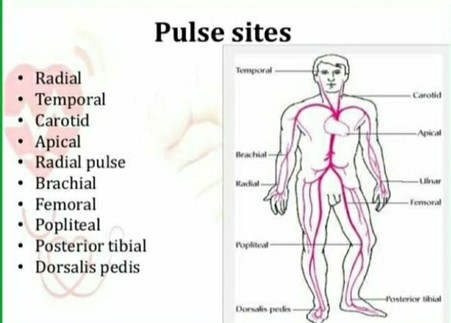The practical nurse (PN) prepares to remove a client's saline lock. Which supplies should the PN gather? (Select all that apply.)
Small gauze pad.
Paper tape.
Three mL syringe.
Exam gloves.
Sterile gloves.
Correct Answer : A,B,D
They are needed to remove the saline lock safely and prevent bleeding or infection. The PN should wear exam gloves to protect themselves and the client from contamination, apply a small gauze pad over the insertion site, and secure it with paper tape after removing the saline lock.
Nursing Test Bank
Naxlex Comprehensive Predictor Exams
Related Questions
Correct Answer is C
Explanation
- A radial pulse is the pulse felt at the wrist, where the radial artery runs along the thumb side of the forearm. It is one of the most common sites for measuring a person's heart rate.
- To measure a radial pulse, the examiner should place two or three fingers over the radial artery, just below the wrist crease, and apply gentle pressure until a pulsation is felt. The examiner should not use the thumb, as it has its own pulse and may interfere with the accuracy of the measurement. The examiner should count the number of beats for 15, 30, or 60 seconds, depending on the regularity and rate of the pulse.
- In the picture, the unlicensed assistive personnel (UAP) is using the thumb to measure the radial pulse, which is incorrect. The practical nurse (PN) should demonstrate the correct pulse site to the UAP and explain why using the thumb is not appropriate. This will help to ensure that the UAP obtains an accurate and reliable pulse rate for the client.
Therefore, option C is the correct answer, while options A, B, and D are incorrect.
Option A is incorrect because instructing the UAP to report any abnormal findings does not address the error in technique.
Option B is incorrect because reminding the UAP to check the pulse volume does not address the error in technique.
Option D is incorrect because confirming the accuracy of the pulse rate obtained by the UAP does not address the error in the technique.

Correct Answer is A,B,C,D
Explanation
This client has the highest priority, as he or she may be experiencing an acute asthma attack that can compromise the airway and oxygenation. The PN should assess the client's respiratory status, administer bronchodilators, and monitor for improvement or deterioration.
B. A 7-year-old child who has type 1 diabetes mellitus and is experiencing extreme hunger and shakiness.
This client has the second highest priority, as he or she may be experiencing hypoglycemia, which is a low blood glucose level that can cause neurologic symptoms such as confusion, seizures, or coma. The PN should check the client's blood glucose level, provide a source of glucose, and monitor for recovery or complications.
C. A 10-year-old child with bleeding lacerations on both knees after falling on the playground.
This client has the third highest priority, as he or she may have a risk of infection or blood loss from the wounds. The PN should clean and dress the lacerations, apply pressure if needed, and check for signs of infection or inflammation.
D. A 5-year-old child who is crying uncontrollably because of an incontinent bowel episode.
This client has the lowest priority, as he or she does not have a life-threatening or urgent condition, but a psychosocial or emotional issue. The PN should provide comfort and reassurance to the child, change his or her clothes, and explore the possible causes of the incontinence.
Whether you are a student looking to ace your exams or a practicing nurse seeking to enhance your expertise , our nursing education contents will empower you with the confidence and competence to make a difference in the lives of patients and become a respected leader in the healthcare field.
Visit Naxlex, invest in your future and unlock endless possibilities with our unparalleled nursing education contents today
Report Wrong Answer on the Current Question
Do you disagree with the answer? If yes, what is your expected answer? Explain.
Kindly be descriptive with the issue you are facing.
